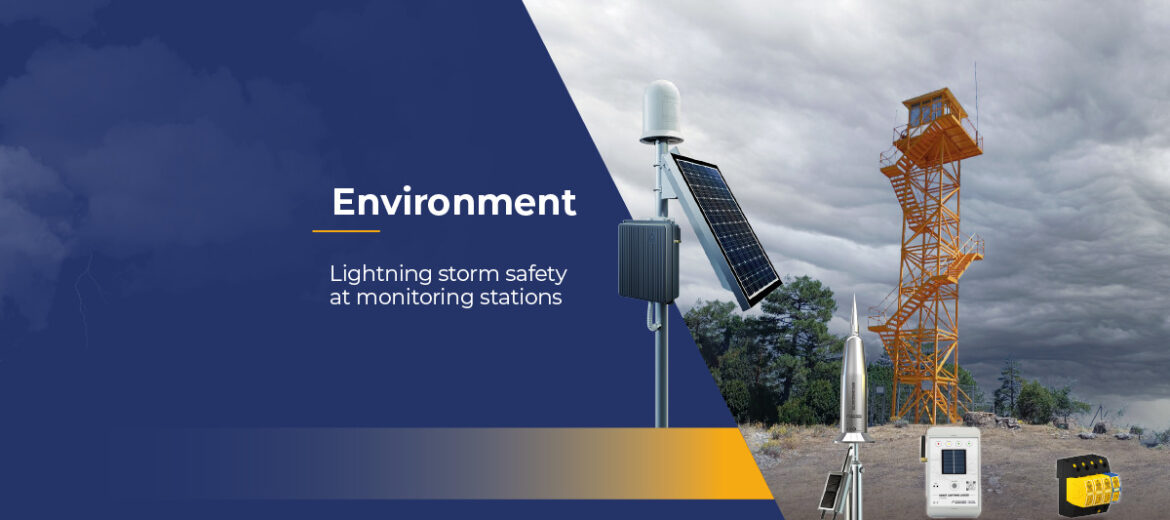Environmental monitoring posts play a crucial role in protecting natural resources of great ecological value. Due to their characteristics, as they are located at a height and in open areas, they are extremely sensitive to the effects of a thunderstorm, which can endanger both the infrastructure and the safety of workers.
Environmental monitoring posts are facilities used for the observation and monitoring of natural resources and biodiversity. These posts are located strategically, such as mountains or hills, from where a panoramic view of the area to be monitored can be obtained. Workers at these posts are tasked with detecting human activity that may endanger the environment and biodiversity, such as poaching or illegal logging.
In addition, environmental monitoring posts are very important for the protection of the environment from the risk of forest fires, since these workers must act in the first instance when a fire starts in the monitored area. Forest fires, both arson and those caused by natural phenomena such as lightning, are responsible for destructing large forest masses, causing significant losses, especially during the summer.
Due to the characteristics of the installations (high areas and open areas), workers at these posts stand exposed to the dangers of electrical storms, which can cause great material and personal losses. For this reason, in addition to the worker’s basic safety knowledge, the post must have adequate protection to minimise the risks to physical integrity and the installations, adapted to the particularities of the terrain.
Environmental monitoring posts: safety advice for thunderstorms
In the event of a thunderstorm or the risk of one occurring, the first safety rule is to switch off electrical appliances. Environmental monitoring posts
- Switch off the radio so that the antenna does not attract any sparks.
- Disconnect the batteries to prevent them from being affected and causing damage in the event of a power surge.
- Disconnect the coaxial cable from the antenna to the radio, so that the radio is not damaged in the event of a spark.
With the storm on the ground, the important thing is to keep all entrances closed (windows and doors) and wait for it to pass.
Ground sockets at guard posts usually consist of 100m of buried cable, so they cover a large area around the guard post and staying close to it when lightning strikes can be a serious risk. Inside the post, there is no such risk, but dizziness and vertigo can occur when lightning strikes. This is due to a small part of the wave that can be transmitted inside the post, which can be avoided by using an insulating mat.
Security solutions for thunderstorm safety at environmental monitoring station
Besides the following basic safety advice during a thunderstorm, the environmental monitoring station must have protection systems appropriate to the environment. These systems range from preventive protection, capable of issuing warnings if a thunderstorm is forming or approaching; external protection to capture discharges (lightning rods) and surge protection systems to minimise damage to electrical components and the possibility of sparks that could cause a fire.
It is important that the guards are involved in the maintenance of the lightning rod in order to ensure optimal protection conditions, as they are the ones who are permanently there and are the ones who will receive the protection.
The guards must immediately report any damage or anomaly, such as:
- Bent, damaged or stolen head or mast.
- Down conductor cable sectioned or stolen.
- Unearthed or severed earthing cable.
Within these tasks, it is important to know that:
The tip of the head must be 2 metres above everything (antennas, etc.).
Antennas must be attached to the lightning rod down conductor. Either with a guardrail, cable or through the railing/structure.
The down conductor clamps must not be insulated, so that sparks do not fly between the down conductor and the structure.
The earthing chamber must be located and covered with something, such as a stone, to prevent it from becoming a nest for animals.
The earthing cable should be buried, although this can be difficult in areas of pure rock. It is therefore advisable to cover it with stones to prevent sparks from sparking and setting fire to nearby grasses. It is also important to be careful where the cable is buried in case an animal digs it up, as they could cut it and thus cause a spark in that area.
Preventive protection
ATSTORM® is a smart thunderstorm early warning system, designed to activate and deactivate temporary preventive actions that minimise risks derived from a possible lightning strike. The ATSTORM® thunderstorm detection system is a solution supported by IoT technologies, based on the evaluation of conditions of an area to be protected and multiple data that support the expert algorithms.
ATSTORM® uses dual sensing technology to provide reliable and objective stop alerts. On the one hand, sensors measure the local electrostatic field to provide warnings of storm formation in the area. In addition, it includes electromagnetic field sensors, which extend the detection area for approaching active thunderstorms.
The collected data goes to the cloud where expert algorithms accurately and precisely identify the conditions of a forming storm or an approaching storm in the area. The processed information is sent to the user as alerts, allowing sufficient time in advance to initiate preventive actions.
With this system, the officer in charge of the post can take appropriate measures to protect themselves in accordance with the above advice.
External protection
The smart lightning conductor DAT CONTROLER® REMOTE is a device with self-diagnosis of its head and communication via IoT (Internet of Things) of the result, to supervise the correct operation of the equipment remotely. The DAT CONTROLER® REMOTE allows daily self-testing of the lightning conductor status, without the need to disassemble it or use auxiliary lifting equipment.
The results of its autonomous test are sent via M2M communication to a receiving device (mobile phone, tablet, computer). This information can be consulted on its web portal along with other customised notifications, thus facilitating correct preventive maintenance and cost reduction associated with late repair of any component.
Every lightning strike and its effect on lightning protection systems, from interception to earthing, is different. Therefore, it is essential to know the detailed information of each discharge in order to anticipate inspections and make critical repairs to ensure that it will continue to operate efficiently.
SMART LIGHTNING LOGGER continuously monitors electrical activity in down conductors of a lightning protection system in which it is installed. When a discharge occurs, the device collects all the information
All this data is sent to the AT-CLOUD, where expert algorithms process it to provide real-time alerts via the CONNECT platform. This allows the urgency to be determined and an early repair to be scheduled in case of a claim.
Para saber más sobre nuestras soluciones para mejorar la seguridad durante tormentas eléctricas, puede contactar con nosotros a través de este enlace.
Además, si lo desea, puede asistir a cualquiera de nuestras formaciones online gratuitas sobre protección contra el rayo disponibles cada mes en nuestra página de webinars.



